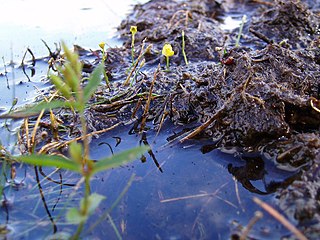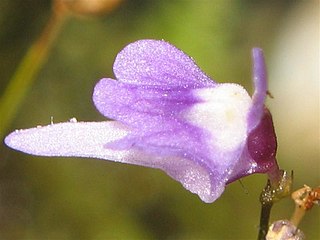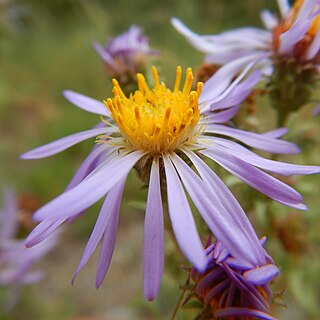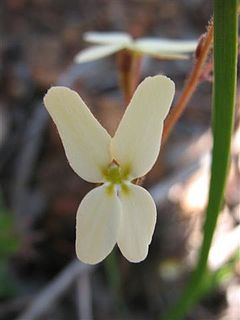The Catalogue of Life is an online database that provides the most comprehensive and authoritative index of known species of animals, plants, fungi, and microorganisms. It was created in 2001 as a partnership between the global Species 2000 and the American Integrated Taxonomic Information System. The Catalogue interface is available in twelve languages and is used by research scientists, citizen scientists, educators, and policy makers. The Catalogue is also used by the Biodiversity Heritage Library, the Barcode of Life Data System, Encyclopedia of Life, and the Global Biodiversity Information Facility. The Catalogue currently compiles data from 168 peer-reviewed taxonomic databases, that are maintained by specialist institutions around the world. As of June 2021, the Catalogue lists 1,997,284 of the world's 2.2m extant species known to taxonomists on the planet at present time.
Swintonia is a genus of plants in the family Anacardiaceae.

Utricularia olivacea, the piedmont bladderwort, is a very small, annual suspended aquatic carnivorous plant that belongs to the genus Utricularia. Utricularia olivacea is native to Central America, South America, the West Indies, and the eastern United States.
Utricularia geoffrayi is a small, probably perennial, terrestrial carnivorous plant that belongs to the genus Utricularia. U. geoffrayi is native to Indochina and can be found in Cambodia, Thailand, and Vietnam. It was originally published and described by François Pellegrin in 1920. It grows as a terrestrial plant among short grasses in or around rice fields at altitudes from sea level to 1,300 m (4,265 ft). It has been collected in flower between September and December.

Utricularia minutissima is a small or very small terrestrial carnivorous plant that belongs to the genus Utricularia. U. minutissima is native to Asia and Australia. Among the islands of Southeast Asia, it is found on Borneo, New Guinea, and Sumatra.

Symphyotrichum campestre is a species of flowering plant of the family Asteraceae commonly known as western meadow aster. It is native to much of western North America, from British Columbia, California, and the Rocky Mountains region to Arizona and New Mexico, where it grows in many habitats, generally at some elevation.

Sedum perezdelarosae is a species in the genus Sedum.

Cappparis micracantha is a species of flowering plant in the caper family (Capparaceae). It grows as a shrub or small tree, sometimes with a more or less climbing habit.
Ryania speciosa is a species of plant in the family Salicaceae.
Walsura robusta is a tree species described by William Roxburgh; it is included in the family Meliaceae. No subspecies are listed in the Catalogue of Life. In Vietnamese its name is lòng tong.

Suregada multiflora, sometimes called the "false lime tree", is a species in the family Euphorbiaceae. The Catalogue of Life lists no subspecies. It is found in tropical Asia: names include kén or mân mây in Viet Nam.
Garcinia multiflora is a tree species in the family Clusiaceae. No subspecies are listed in the Catalogue of Life.
Alstroemeria discolor is a species of monocotyledonous plants from Alstroemeria genus, Alstroemeriaceae family, described by Pierfelice Ravenna. According to Catalogue of Life Alstroemeria discolor does not have any known subspecies.

Adenia subsessilifolia is a species of flowering plant in the passionflower family, Passifloraceae, described by Joseph Marie Henry Alfred Perrier de la Bâthie. Adenia subsessilifolia is endemic to southern Madagascar. No subspecies are listed in the Catalogue of Life.

Anisoptera thurifera is a tree species in the family Dipterocarpaceae. This Asian species has been recorded from Bangladesh through to New Guinea; the IUCN has categorised it as Vulnerable.

Lyonia ferruginea, the rusty staggerbush, tree lyonia, dragon tree, is a plant of the genus Lyonia. It was first described by Thomas Walter, and was named by Thomas Nuttall. No subspecies are listed in the Catalog of Life.

Stylidium piliferum is a species of dicotyledonous plant from the genus Stylidium. It is found in Western Australia.

Silene sorensenis, the three-flowered campion or Sorensen's catchfly, is a species of plant in the family Caryophyllaceae. It is found in the tundra of the Canadian Arctic Archipelago, the Northern Russian Far East and Greenland.

Symphyotrichum leone is a species of flowering plant in the family Asteraceae native to Cuba. It is also spelled Symphyotrichum leonis.











